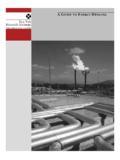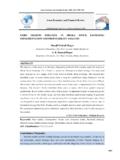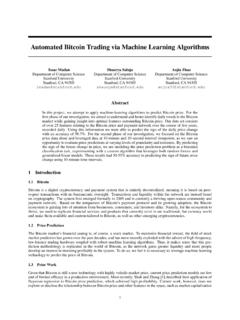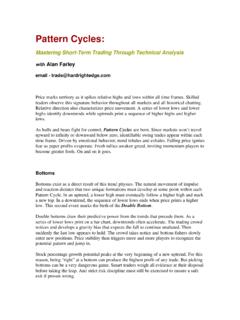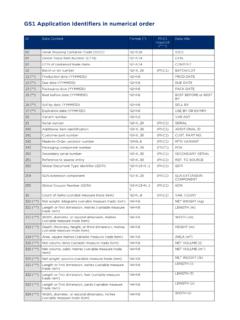Transcription of New York A GUIDE TO NYMEX/COMEX. Two …
1 A GUIDE TOMETALSHEDGINGNew YorkMercantile ExchangeNYMEX/ comex . Two divisions, one marketplace1 Significant, sometimes abrupt, changes in supply, demand, and pricing havetouched many of the world s commodity markets during the past 25 years, includingthose for metals. International politics, war, changing economic patterns, and struc-tural changes within the metals industry have created considerable uncertainty as tothe future direction of market conditions. Uncertainty, in turn, leads to market volatil-ity, and the need for an effective means to hedge the risk of adverse price exposure. The principal risk management instruments available to participants in the metalsmarkets today are the versatile futures and options contracts listed on the New YorkMercantile Exchange. The contracts are designed to meet the needs of the modernmetals industries by encompassing the standards and practices of a broad cross-sec-tion of the trade.
2 The Exchange is the world s largest physical commodity futures is conducted through two divisions: the comex Division lists futures andoptions on gold, silver, copper, aluminum and the FTSE Eurotop 100 and FTSEE urotop 300 European stock nymex Division offers futures and options contracts for platinum; light, sweetcrude oil; heating oil; New York Harbor gasoline; natural gas; electricity; futures forpalladium, propane, and Middle East crude oil, and options contracts on the price dif-ferentials between heating oil and crude oil, and New York Harbor gasoline and crudeoil which are known as crack spread Division gold futures began trading in 1974 to coincide with the repeal ofthe ban on the private ownership of gold in the United States. The nymex Divisionplatinum contract, launched in 1956, is the oldest continuously traded precious met-als futures contract in the world.
3 The metals complex has evolved into the principalpricing indicator for the world gold, silver, and platinum group metals markets and theNorth American copper trade. Aluminum futures opened for trading in May TO THENEWYORKMERCANTILEEXCHANGE* FTSE , FT-SE , and Footsie are trade and service marks of London Stock Exchange Ltd. and The Financial Times are used by FTSE International Ltd. ( FTSE ) under license. Eurotop is a registered trademark of AmsterdamExchanges ( AEX ) or its subsidiaries and is used by FTSE under license. All copyright in the index values and con-stituent list vests in FTSE International Limited. The FTSE Eurotop 300 is calculated by FTSE International Limited inconjunction with Amsterdam Exchanges and the Institute of Actuaries and the Faculty of Actuaries in accordance with a stan-dard set of ground rules.
4 FTSE and AEX accept no liability in connection with the trading of any contract on the ACCESS The Exchange s after-hours electronic trading system, nymex ACCESS , allowstrading in palladium futures, comex Division metals futures and nymex Division plat-inum and energy futures and options after the trading floor has closed for the day. TheNYMEX ACCESS trading session for gold, silver, platinum, palladium, aluminum, andcopper begins at 4 , New York time, and concludes at 8 the following morn-ing, Mondays through Thursdays. A Sunday evening session commences at 7 ,New York time. When combined with the daily open outcry session, NYMEXACCESS extends the trading day to approximately 22 hours. Terminals are in use in major cities in the United States and in London, Sydney,Hong Kong, and Markets Require Diverse ParticipantsTo be efficient and effective risk management instruments, futures markets requirea mix of commercial hedgers and private speculators.
5 The New York MercantileExchange s metals markets have attracted private and institutional investors who seekto profit by assuming the risks that the underlying industries seek to avoid, inexchange for the possibility of rewards. These investors, in combination with hedgers, have brought a diversified balanceof participants to the Exchange s a Transaction WorksThe execution of a transaction on the trading floor is a finely honed process thatcan be completed in seconds. The open outcry auction process on the floor assuresthat transactions are completed at the best bid or process starts when a customer places an order to buy or sell futures oroptions contracts with a representative on the trading floor via telephone, computerlink or the firm s back office. An order slip is immediately prepared, time stamped, andgiven to a floor broker who is an Exchange member standing in the appropriate trad-ing buy and sell transactions are executed by open outcry between floor brokersin the same trading ring.
6 Buyers compete with each other by bidding prices compete with each other by offering prices down. The trade is executed at thehighest bid and lowest offer, often known as the bid-ask spread. Meanwhile, ringreporters listen to the brokers for changes in prices and enter the changes via hand-held computers, immediately disseminating prices to the commercial price reportingservices as they simultaneously appear on the trading floor of each completed trade is immediately sent by the floor broker sclerk to the originating broker or are Futures?Futures contracts are firm commitments to make or accept delivery of a specifiedquantity and quality of a commodity during a specific month in the future at a priceagreed upon at the time the commitment is made. The buyer, known as the long, agrees to take delivery of the underlying commodity.
7 The seller, known as the short, agrees to make delivery. Only a small number of contracts traded each year result indelivery of the underlying commodities. Instead, traders generally offset (a buyer willliquidate by selling the contract, the seller will liquidate by buying back the contract)their futures positions before their contracts mature. The difference between the initialpurchase or sale price and the price of the offsetting transaction represents the real-ized profit or contracts trade in standardized units in a highly visible, extremely competi-tive, continuous open auction. In this way, futures lend themselves to widely diverseparticipation and efficient price discovery, giving an accurate picture of the market. To do this effectively, the underlying market must meet three broad criteria: Theprices of the underlying commodities must be volatile, there must be a diverse, largenumber of buyers and sellers, and the underlying physical products must be fungible,that is, interchangeable for purposes of shipment or market participants must work with a common denominator.
8 Each understandsthat futures prices are quoted for products with precise specifications delivered to aspecified point during a specified period of , deliveries of most futures contracts represent only a minuscule share ofthe trading volume; typically less than 1% in the case of metals. Precisely because theExchange s physical commodity contracts allow actual delivery, they ensure that anymarket participant who desires will be able to transfer physical supply, and that thefutures prices will be truly representative of cash market values. Most market participants choose to buy or sell their physical supplies throughtheir regular channels, using futures or options to manage price risk and liquidatingtheir positions before Use New York Mercantile Exchange Contracts? nThe contracts are standardized, accepted, and therefore liquid Exchange offers cost-efficient trading and risk management and options contracts are traded competitively on the Exchange inan anonymous auction, representing a confluence of opinions on their futures and options prices are widely and instantaneously dissemi-nated.
9 Futures prices serve as world reference prices of actual transactions betweenmarket Exchange s markets allow hedgers and investors to trade anonymouslythrough futures brokers, who act as independent agents for liquidity of the market allows futures contracts to be easily liquidatedprior to required receipt or delivery of the underlying futures contracts are seldom used for delivery, if delivery is required,financial performance is guaranteed, as it is for options that are exercised. Unlikeprincipal-to-principal transactions which must be carefully examined for expectedfinancial performance, counterparty credit risk is absent from transactions executed on the Exchange. nFutures and options contract performance is supported by a strong financialsystem, backed by the Exchange s clearing members, including some of thestrongest names in the brokerage and banking Exchange offers safe, fair, and orderly markets protected by its rigorousfinancial standards and surveillance Applications of the Exchange s Metals Futures and OptionsThe Exchange provides buyers and sellers with price insurance and arbitrageopportunities that can be integrated into cash market Exchange contracts can reduce the working capital requirements and thephysical storage costs associated with physical market Exchange contracts can improve the credit worthiness and add to theborrowing capacity of natural resource companies, thus augmenting the companies financial management and performance vs.
10 Futures Prices The Contango Price RelationshipCash prices are the prices for which the commodity is sold at the various marketlocations. The futures price represents the current market opinion of what the com-modity will be worth at some time in the future. Under normal circumstances of ade-quate supply, the price of the physical commodity for future delivery will beapproximately equal to the present cash price, plus the amount it costs to carry orstore the commodity from the present to the month of delivery. As a result, one wouldordinarily expect to see an upward trend to the prices of distant contract costs, known as carrying charges, determine the normal premium over cash,and create a market condition known as contango which is typical of many futuresmarkets. In most physical markets, the crucial determinant of the price differentialbetween two contract months is the cost of storing the commodity over that particularlength of time.


